Mixed bones, which means that bodies were indiscriminately thrown on one another, skulls with a hole in the rear – whoever saw the human remains unearthed in June this year near the entrance to a former nunnery will never forget it. Arguably, there are about 20 mass graves like this on the territory of old Lutsk – of the nationally conscious Volyn residents imprisoned by “liberators” in 1939 and shot by NKVD butchers in June 1941, the Soviet prisoners-of-war killed by the Nazis, and thousands of Jews. The pit with the remains, found in June, is next to the entrance to a historical structure, a monument of national importance, – the former St. Bridget’s Convent. This state-owned property is now under a lease of the Volhynian Eparchy of the Ukrainian Orthodox Church (Kyiv Patriarchate). The lease being a temporary arrangement, the building was at first intended to be a monastery, but, as it is very large, the clergy decided to set up… a hostel here. A few rooms have already been renovated for this very purpose.
Den/The Day has written more than once that the public rejects this idea. Lutsk and Volyn residents know that St. Bridget’s Convent premises used to house not only a music school for several decades, but also a prison from 1890 until the 1960s. This building has always been a place of sorrow for Volhynians. As Pavlo Rudetskyi, director of the historical and cultural preserve “Old Lutsk,” told us, the public welcomed the idea to establish “Volhynian Golgotha,” a museum of the victims of totalitarian regimes; repositories of Lutsk museums (there is enough room for this); and a Ukrainian Insurgent Army museum (as is known, the UPA was formed in Volyn) here. But something went wrong with the museums, whereas all is OK with the hostel.
Moreover, the Volyn media often quote the Volhynian Eparchy spokesman Archimandrite Kostiantyn (Marchenko) as saying that the hostel may be stylized as… an NKVD “reception room.” “Receptionists” will wear the NKVD uniform, and customers will rest on beds in the shape of prison bunks. Father Kostiantyn told The Day’s correspondent that this tourist attraction was only talked about. But, as no other than the local clergy is involved in the reconstruction (and the eparchy does not deny that the building is being renovated to be a hostel), this clearly arouses concern among the public, historians, and, naturally, the relatives of those executed within these walls. Many of them came to this sorrowful place when the found human remains were being exhumed. “A relative of mine was tortured to death here. It hurts me to think that now it’s going to be a place for thrill-seekers,” one of the relatives says. “Maria Karpun, a longtime prisoner and a participant in the Norilsk uprising, used to say, recalling her stay at the Lutsk jail, that nobody wanted to sleep in a corner, where there were fresh blood stains – a woman and her child had been tortured to death. So, will the guests be able to sleep quietly at a place where the blood of slaughtered Ukrainians was spilled?” student Roman NOVOSAD, a Den contributor, asks.
As is known, there was also an intention to set up a hotel on the premises similar to the Lutsk jail – the Loncki Prison in Lviv. But the Leopolitans had enough common sense to ward this off. Viktoria SADOVA, deputy director of the National Memorial Museum of the Victims of Occupational Regimes “Loncki Prison,” told The Day that it would be amoral to set up a hotel in a prison. What constitutes a value is the very building of the former prison, where the inmates’ cells were restored in the original shape. And this makes a much deeper impression on visitors than what may be set up in the Lutsk jail’s hostel. Sadova notes that very many people died in these prisons, so it is important not to exceed certain moral limits.
The trouble is that these ethical nuances do not in fact matter to the Lutsk authorities – otherwise, even the clerical sector would see that it must coordinate its plans with the society it coexists with.








